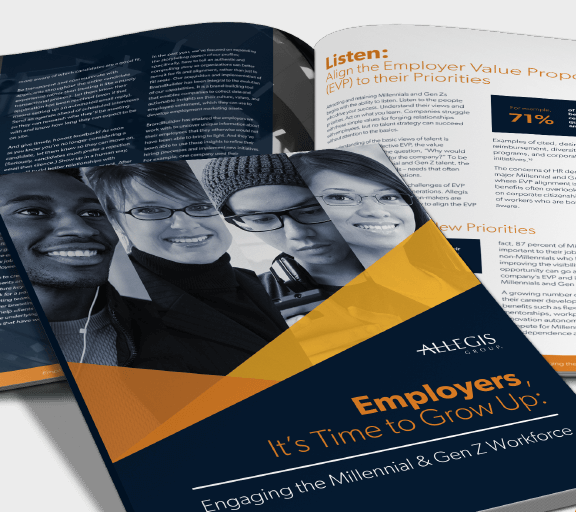Importance of Employee Advocacy to Your Employer Brand Strategy

Blog authored by Craig Fisher, Head of Global Marketing, Allegis Global Solutions, an Allegis Group company
As an employer brand strategy leader and consultant to companies in some of the most competitive markets for talent, I’ve seen how organizations struggle to bring their stories to life. A well-executed marketing plan can help get the story out, but for Millennial and Gen Z talent, traditional marketing is greeted with skepticism. The real story lies in the hands of the people who live the employer brand every day. Those people are the most available, most powerful, and most cost-effective employer brand resource a company has: they are its employees.
When an employer establishes its employees as champions and advocates of the company, people listen, and we have the numbers to prove it. For example, in a recent effort with major IT employer CA Technologies, we developed an employee advocacy program that achieved a tenfold increase in audience for its digital content and an estimated $300,000 in savings over traditional advertising costs while achieving measurable improvement in how people interact with content.
Cracking the Code of Effective Employee Advocacy
Most employers recognize that employee reviews on Glassdoor and activity on LinkedIn, Facebook, and Twitter can make all the difference in swaying a potential candidate toward an organization. Unfortunately, employee advocates can be elusive.
The organization that simply encourages people to talk positively about the company on social media will achieve little impact on its ability to attract talent. Instead, organizations need to establish their story, identify their brand champions, give those champions the technology and training to succeed, and, above all, measure results. With that in mind, the following keys to an effective advocacy strategy can make all the difference in creating a growing and impactful human voice that brings your employee brand to life.
Understand Your Employee Value Proposition (EVP)
Is your organization truly a good place for fast-acting risk-takers and self-starters, or is it more of a family that brings together many perspectives to take a deliberate approach to projects, problems, and opportunities? These are the types of questions an EVP will answer. By assessing and understanding the real qualities that make your organization the employer it is today, a company then has the means to develop the messaging that employees can promote through their social channels.
Find Champions
To get the employee advocacy program off the ground, the organization must take an active role in developing influencers. A conventional survey can help identify the most obvious champions, but an internal social media effort is likely to help pull in more potential advocates. In any case, the employer brand must be sold internally and externally, and it must be accompanied by an intentional effort at targeting champions to promote the message.
Use the Right Technology
In the case of CA Technologies, the platform we used to drive employee advocacy proved instrumental to the success of the program. Through the use of an innovative employee advocacy solution, we were able to give employees one place where they can share messages out to their networks.
The platform provided ease of use, a positive experience for employees, and measurable results for sharing content and tracking views. Through our #LifeAtCA program and using the employee advocacy platform, employees were talking about all aspects of their work through Instagram, Facebook, and Twitter. Shortly into the program, employees began lining up to participate.
Measure, Measure, Measure
An employer brand initiative only achieves lasting impact if there is some way to track performance and success. Thanks to the focused strategy and technology platform we applied at CA, we knew what we wanted to measure, and we had the means to measure it.
As a result, we can now say that we achieved a 1,019 percent increase in audience for our messaging, as well as a 33 percent boost in overall audience reach. Plus, the overall content we posted received an average of 70 percent more clicks compared to pre-initiative activity.
The Final Ingredient: Live the Brand
The employer brand advocacy strategy is not limited to current employees and conventional messaging. In fact, any person who interacts with the company can be an advocate if they had a positive experience. If handled well, even the candidate who is rejected for a role can be turned into a champion.
At CA, we set up a system for assessors to identify where candidates stood in relation to the role requirements. Obviously, the yes’s would move on in the process, but for the no’s, we sent a personal response, thanking them for applying, telling them we’ll keep in touch in case another opportunity comes up, and inviting them to join our talent communities. The positive response from talent was overwhelming. We know many of them had become an advocate within their networks, and, in some cases, the company later hired them.
Together, the employee advocacy strategy and related technology underscore the extent to which the rules of branding have changed. Marketing is much more than advertisements, logos, campaigns, and taglines. When friends and colleagues have something good to say about your organization, people will listen and believe. No amount of marketing fireworks can substitute for a voice of trust. That’s what employee advocacy brings, and it’s a quality that can put an organization in front when competing for scarce talent of any age.
Recruit and Retain NextGen Talent
Download our free white paper to capitalize on the newest generations in the workforce. Get your copy of “Employers, It’s Time to Grow up: Engaging the Millennial and Gen Z Workforce” today.
Author’s Bio: Craig Fisher is Head of Marketing and Employer Brand SME at Allegis Global Solutions, an Allegis Group company. He has consulted with companies like CA Technologies, Hootsuite, Yum! Brands, LinkedIn, FOX News, and many more on sales, brand, and recruitment strategy. Connect with Craig on Twitter and Instagram @fishdogs, and on his blog at www.fishdogs.com.


